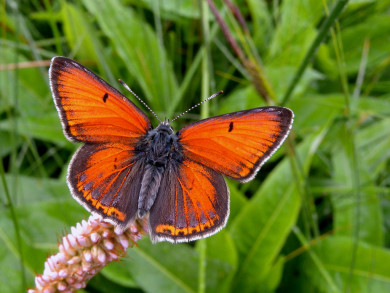
Lycaena hippothoe (Purple-edged Copper): one of the species to have disappeared from Habel et al.’s study area in Germany. © Frank Vassen
You may have known that excess nitrogen pollution detrimentally affects watershed health (e.g., the Gulf of Mexico), by promoting hypoxic (low oxygen) zones. An increasing number of research publications, however, have also linked increased atmospheric nitrogen loads with changes in plant, and butterfly and moth communities. Most recently, Habel et al., in the journal Conservation Biology, described this transition using nearly two centuries of lepidopteran data submitted by amateur and professional biologists in Germany.
From 1840 to 2013, Habel et al. determined that the number of butterfly and diurnal moth species in southeastern Germany declined from 117 to 71. Through time, the lepidopteran community became dominated by a handful of habitat generalist species, while habitat specialists and those species with poor dispersal ability became increasingly rare. Habel et al. linked these trends to homogenizing changes in the host plant community, likely driven by increasing nitrogen levels in the region. Larval host plants that thrive in low-nitrogen environments (e.g., bogs, calcareous grasslands, and heathlands) were gradually replaced with common, open-habitat plant species that favor nitrogen-rich environments.
The potential for similar trends to be documented in North America could be facilitated by eButterfly: an online checklist program that garners the observational data of recreational watchers and professional lepidopterists for science and conservation.
Press release from the Technical University of Munich.
